CPOY 74 Director Jackie Bell lays out the importance of CPOY, and why you should submit your own work next year!
Jackie Bell, CPOY Director from CPOY/POYi on Vimeo.
CPOY 74 Director Jackie Bell lays out the importance of CPOY, and why you should submit your own work next year!
Jackie Bell, CPOY Director from CPOY/POYi on Vimeo.
CPOY Coordinator Yanran Huang interviewed Brittainy Newman of Rochester Institute of Technology, who was the gold winner of Individual Story or Essay - Standalone in 2018.

Nancy B.B. Meyer is a firm believer that animals are angels. Meyer has been adopting and helping to place animals from shelters for over 50 years. From dogs and cats to snakes, goats, and pigs, Meyer has been able to find a home for every animal brought to her attention. And she's never given up on an animal because it's old or sick or has been abused.
---
Yanran Huang: Could you talk about The Love Shack?
Brittainy Newman: The Love Shack was created during my senior year in college. I studied at Rochester Institute of Technology in Rochester New York and I graduated 2018. And so the Love Shack was a project I created actually in a portrait class. But I thought like this was a great character study. So I thought it’s kind of acted as a portrait in a way like a moving portrait of this woman named Nancy Meyers who lives in Rochester New York and lives in like a house that is all about giving love and spreading love. And I was really drawn to the house and to her obviously because the house itself is covered in hard. It’s super visual and crazy. I knocked on the door asking like who lives in here and just to like tell me more about herself and she was really open to being recorded and having her story shared. I ended up using a drone for like the beginning and ending shot. I didn't actually shoot the drone footage. I have an artistic director in that. I had a fellow student named Brian Bennett. And so I was like learning a whole bunch of new things while shooting this. I brought a light to do the interview. Technical wise I was learning a lot of things to do this project. The project is about Nancy Meyer and how she's all about spreading love and giving it. She was once battered in like the eighty's and so the house kind of access of the place where women who have been formally abused or like a domestic abusive relationship can come to her and like feel the love. But now she has transformed the house like her mission into helping the homeless and helping rescue the animals. In the film you can see like not only her and her husband in the kind of like a little day to day. They go out and celebrate Thanksgiving dinner with her and like all these homeless people. The dinner used to be held at the home itself but now they do it at like a nearby supermarket. It was just like a really quirky fun story. I'm really into quirky stories. So I'm really into people who just like have like a strong passion and like kind of artists to get their feel.
YH: Did you meet any difficulty while doing the story?
BN: I think it’s always difficult to tell a story. I have the curse of knowledge of like knowing everything about this woman so how do I convey that to viewers who know nothing through like video and through editing. So I think editing this project was definitely difficult. It took a lot of different iterations. I had a lot of different eyes looking at it to give me feedback like if it’s make sense, does it look like I'm making fun of her, the music choice and everything needs to be paid attention to.
I guess another difficult thing was this is in the dead of winter even though she was like a couple blocks down. I guess also just like that person was weird, getting this done, there is no story is important and you want to continue doing it. So staying motivated and keeping the people that you're working with, like my other assistant shooters or like Brian, for example, who helps with the drone, you know, keeping the motivated to be. Yes, this is important. So let's go and get up and let’s do this. I think that's another difficult thing that always happens in any project.
Nancy loves the piece, she still talk to me this day, the main character. And it's received so much good feedback like COPY. That was such an honor to receive 1st place that was like honestly really surprised me going insane.And so yeah I am I'm really happy with the response that project is getting.
YH: How is your fellowship in the New York Times going?
BN: I love it. Honestly, it’s a dream come true. I have assignments every day including weekends sometimes, like 7 days a week. My back is killing me carrying tons of different equipment because I never know what I'm shooting every day. Sometimes I get notified if I have been assigned that day that hour and so I always have reasonable lens in my backpack. But I love it. It's really an amazing opportunity and it's like brought me to so many different people. Photojournalism in general is like my keys of the world in a way. So people can allow you into their lives. That's such an amazing thing, the trust that comes with that, the relationship and friendship. That's all still happening while on assignment for them. I get amazing feedback from my editors you know. Tomorrow actually my college is visiting The New York Times. They always do meetings with different companies. So it's kind of cool full circle that like my college’s visiting and I’ve already is an alumna to present.
But it's really intense. It's cool. It's hard. Sometimes I think I like is long term, storytelling like documentary work. The majority of the assignments that I receive are actually portraits, building mugs and photographing sports a lot which I'm not like an expert on. But they want you to shot how you shot, not like how a Getty photographer or AP photographer shot. So it's really cool to just kind of staying in my own zone and show what I have to offer but then also have to learn all these so fast, like lighting and portraiture and so utilizes everything that I learned in college ten times. But it's really cool and I get to meet reporters and writers and seeing the story published in the paper. I get tear sheets via email and like seeing it like in person as it's like the coolest feeling. I got my 1st front page for the 9.11 memorial so that was also like a huge honor. It only makes me want to work harder and strive more.
YH: What’s your future plan?
BN: My main goal has always been to work on that a documentary film project. I'm working on one right now about virginity auction. There's these girls that are like selling their virginity online like hundreds of thousands of dollars and I already went to Peru and documented a girl for a week. Right now I'm playing the grants and hopefully getting funding from other sources to continue that and get some new equipment. I really for the future just like want to win an Oscar and like be on the red carpet and just be part of a team. That's really involved in like one long term like story. But I think that won’t happen for like a couple years. I think I still need I like having like that the work I can’t imagine being a freelance there's really hard specially in the video world. It's just not possible. I think you have to be part of the production company if you really want to do video because it just would kill your body, a lot of equipment, funds and everything. But I'm learning every day. This is like a business. So I think it's really interesting. In my future, I just want to continue telling stories in all different medium. I'm really into installation art and immersive storytelling. I eventually want to create an exhibit one day and so just incorporating animation and coding. This is a whole bunch of stuff I think there's a multitude of possibilities of storytelling.
YH: Can you provide some suggestions to college photographers who want to do multimedia in future career?
BN:Watch a lot of stuff. I spent all my free time in college, like in between classes, just watching New York Times op docs and going on the Vimeo page and looking at strictly college work and professional work. I would look at the in the school of journalism all their video works. Everyone's experience and life is different than yours. So the way they speak helps and impacts you and change your perspective personally and professionally. I just think it's really really important to watch films like from the 1970s, 60s, and looking at real cinema, composition and dialogue.
And then also, take your time when it comes to editing and how telling the story right. I like to be really hands on with how I edit. If I doing a couple interview, I transcribe everything, cut out the transcription, paste it on my wall all these stuffs. I think it's nice and fun to hands on and collaborative with your classmates and listen to them. I think a lot right now in college for photojournalists is very competitive. But your classmates are like your future resources so I think it's important to remember that and that can push them away from the competitions. I don't know. Just do it, do the work. It's a really really hard work. Who’s gona see this. Who’s cares. It might be the one doesn’t care. And you have to strive back and look at competitions and see what they look for.
CPOY 74 Judge Adriana Teresa Letorney is the founder and CEO of Visura, a digital platform that specializes in visual storytelling. Watch this video to get to know her a little better!
Adriana Letorney, CPOY Still Image Judge from CPOY/POYi on Vimeo.
Still Division judges Alexa Keefe, Genaro Molina, Adriana Teresa Letorney, and Scott Strazzante sat down with students over lunch to discuss photojournalism, empathy-led work, and more. Here are a few moments from Day 4 of CPOY74.
Photos by India Garrish.

Scott Strazzante of the San Francisco Chronicle talks to students over lunch.

Adriana Teresa Letorney, Founder & CEO of Visura.co, and Alexa Keefe, Senior Photo Editor at National Geographic magazine, exchange ideas.

Genaro Molina, award-winning staff photographer for the Los Angeles Times, in black and white, featuring NPPA.

Alexa Keefe leads the discussion.

Scott Strazzante's boots were made for walking.
CPOY Coordinator Yanran Huang interviewed Gabriel Scarlett of Western Kentucky University, who was the 73rd College Photographer of the Year in 2018.

Julian Rodriguez plays with his son Christopher at their home on Pueblo's East Side. Julian's decades-long struggle with addiction brought him intimately close to the gang operations as he often bought from and sold for the gangs in order to support his own addiction. "Everything that I desire and want in this life is for that boy," he explains. Christopher will grow up on the East Side, deep in Duke territory, but Julian hopes that a loving relationship with his father can keep him away from the gang lifestyle. (Gabriel Scarlett, Western Kentucky University)
---
Yanran Huang: What’s your most difficult story so far?
Gabriel Scarlett: Every story is challenging in different ways—whether it be challenging emotionally, logistically, financially or physically. A few stories have been difficult in all these ways.
When I began documenting life in the East Side neighborhood of Pueblo, Colorado, I had little idea that I would return time and again over the next year as the story grew into “Flock of Doves”, an essay on a community affected by local street gangs.
I attend school in Kentucky, so returning to this story meant several cross country road trips and constantly searching for grant funding. When I was in town, I frequently slept in my car in order to cut down on costs.
At times this story was logistically challenging as I was denied access to one of my subjects who was being held in the Pueblo County Jail.
Looking back at this story, I can see so many of its visual pitfalls and how disjointed its narrative was. One of the biggest takeaways from the story was to be more prepared before I get started. I was truly happy to have put myself out in this community and attempted this story, but if I were to do it again, I would approach the topic with more focus and a clearer idea of the final product and the why behind what I was doing.
YH: How’s your National Geographic internship?
GS: Each year I entered CPOY, my efforts were made with the internship in mind. Since seeing Aaron Huey’s documentation of the Pine Ride Reservation when I was in high school, I wanted to be a National Geographic photographer above all else.
This summer did not disappoint. I was given a very challenging assignment to document Bob Ballard’s search for Amelia Earhart’s Lockheed Electra in the South Pacific. Alongside a television crew of about two dozen who were making a Nat Geo TV special, I was sent as the lone still photographer. I was responsible for filing from the field for several digital stories in real time while simultaneously photographing with the scope of a potential Magazine piece, in case the plane was found and the mystery solved. While that did not happen, it was a wonderful exercise in planning and executing a broad essay of this kind that stretched from Amelia’s hometown of Atchison, Kansas to the remote island of Nikumaroro.
Along the way I learned a little bit of on location lighting as well as how to use an underwater DSLR housing. Freediving and photographing was one of the funnest and most challenging parts of the entire expedition. Even though we only needed one or two good shots from the underwater perspective, I was able to use some of my downtime between shoots to dive along the pristine coral reef at Nikumaroro, seeing plenty of reef sharks, sea turtles, and manta rays.
YH: Can you give advice to college photographers on portfolio?
GS: To me, editing together a CPOY portfolio was like taking stock of myself photographically over the past year. Listening to the screencasts of the judges’ critiques was invaluable and each year I felt I was getting closer to a body of work I could be truly proud of.
I would advise anyone looking to enter a portfolio to simply make it theirs. Don’t be too embarrassed by one or two of your stories that feel half-baked or incomplete. This is not your polished website portfolio, but rather a statement on the work you completed in twelve month’s time. Bring together all your hard drives and start to compile your favorite work from the year. Find your personal voice within that mix and don’t ask too many people for advice. One or two close friends or mentors who know you and your work intimately can help you to hone your vision, but too many opinions can leave you overthinking and confused. I cannot stress enough how much my close friends helped shape my portfolio entries each year, in ways both big and small.
I encourage any and all—no matter what grade in school—to put together a portfolio entry each year. It is such a great exercise in self-editing and so helpful to gauge the “success” of your efforts over the past year and what you may or may not want to do differently in the future. Going forward, I think I will continue to pay attention to the CPOY competition and in particular, the portfolio category as it is always remarkable how much great work can be made by students in just a year.
Here's the percentage of this year's submissions by region! Recognize your home? Infographic by Liv Paggiarino.

Alexa Keefe is a Senior Photo Editor for National Geographic and a still image judge for CPOY 74. She shares advice for young photographers: "Know the story you're telling, it's so much about your unique voice," Keefe says.
You’re looking at every image entered in this year’s Interpretive Eye category, all jammed together into one frame!

Get to know the CPOY still image judges! CPOY Director Jackie Bell and still image judges Alexa Keefe, Adriana Letorney, Genaro Molina and Scott Strazzante talk about their first cameras and what they used to take photos of.
CPOY 74 Know Our Judges from CPOY/POYi on Vimeo.
Here's a breakdown of all the shutter speeds photographers used in this year's entries in the Sports Action category! Infographic by Liv Paggiarino.

Here's a breakdown of the apertures used this year in the Portrait category. Infographic by Liv Paggiarino.


Maritza.This is a collodion tintype photograph, made on location using chemical processes. Photo by Zachary Krahmer
Q1. Why did you choose the collodion tintype photograph?
I chose the medium that I worked with for several reasons. One reason is because of the intentionality and time required for each picture. Each image represents a 5 to 15 minute effort between photographer and sitter for the image to be created. In learning about this part of the world, I found that the majority of voices being broadcast were from the dominant urban narrative where the largest news broadcasters are located. The collodion process requires a level of hands-on communication between the person photographing and the person being photographed. I knew this would provide structure to ask and learn about these individual’s lives and confront my own preconceptions about the group and this conflict. I knew that the medium would really force me to confront that and actually have real conversations with the people that I would be photographing and working with. More so, there are a lot of issues with how the current peace process is being implemented and I thought it was important to make something different from anything I had seen recently made. In some ways because of the medium, more people have been able to see the work, and this means more people have learned and potentially asked questions about what is happening. Additionally, wet plate images are grainless, which means they can be reproduced at very large sizes. I hoped to create life size reproductions of the plates to frame constructive conversations around the peace process. In addition to the tintypes, we returned printed copies of the images to the individual members and coordinated photography workshops with several groups from the demobilizing front, as well as youth within the community where they would be reintegrating so they could document their own transition to civilian life.
Q2. Do you always think hard about what formats to choose for your projects?
I'm beginning to. The ubiquity of imagery requires all photographers to reflect on 'what is it that I hope people will take away from my work? What is it that I'm actually hoping to accomplish with these pictures? And then thinking 'is this the right medium or combination of mediums?' At the end of the day, I believe as image makers we're creating experiences. Lately, I’ve been drawn to creating video with a photography mindset because it provides context, and a chance to convey deeper structural issues. Perhaps augmented reality, or maybe a quick snapshot camera is the best way to tell a story? There are many exciting new technologies out there that can be used to communicate. I think it's the elements of the story and what you're hoping to convey to the viewer that should dictate the medium you choose. We should be receptive when the elements of a story lend themselves to a certain delivery.
Q3. What advice would you give to people trying to do their own interpretive project?
Spend time reflecting on your motivation for doing a project and think about what you can offer from your own life that is unique. This could be a certain perspective, technique, process, or anything. Think about what you’re creating, and why you are photographing. Think about the audience you hope to reach and how you would like to affect them. How does this story relate to other things that people might already know about this topic? The topic itself could be interpretive.
Find something you're really passionate about and think about how you can convey that passion through your process. And just fail. Take a lot of chances and fail a lot. Also, I would say study what's come before you to inform your work. Unlike art in general, photography has been around for less than two hundred years. It’s not impossible to learn the history of photography. Study what has come before you and develop an understanding of how your work might fit into the larger photographic legacy of our shared experience on this planet.
Q&A by Yehyun Kim. Supervising Editor is Liv Paggiarino.
Ross Taylor, Assistant Professor at University of Colorado - Boulder and this year's Multimedia moderator, talks about how his experiences have helped shape his view of documentary journalism.
Eric Maierson, freelance writer and two-time Emmy-winning editor and producer, talks about the heart of storytelling, the changing nature of multimedia and how it's okay to start small.
Whitney Shefte, Award-winning video journalist at The Washington Post, talks about her interests in social issues and telling stories to impact the world.

Senior Lauren Wortman works on the sound board during the Documentary Short Video voting.

Judges (from left) Eric Maierson, Evelio Contreras and Whitney Shefte rest in between voting sessions.
Evelio Contreras, producer, shooter and editor for CNN, talks about his career, personal experience with the Virginia Tech shooting, and how to communicate the language of visual storytelling.
Jackie Bell discusses her first year as the director of the College Photographer of the Year competition.
Here are some scenes from Day Five of CPOY. The judges finished with Still Images yesterday, so they celebrated today at Shakespeare's Pizza. The student volunteers talked with the judges about their experiences in photojournalism.




Molly Roberts, Senior Photography Editor at National Geographic Magazine, discusses the role of women in photojournalism and photo editing.
Don Bartletti, former Los Angeles Times Photojournalist, stresses the importance of the photo story in today's journalistic world.

As Day 3 comes to a close, here's a look at the statistics on entries, countries and mediums participating in CPOY 72.
Deanne Fitzmaurice, freelance photojournalist, compares and contrasts art photography and photojournalism, and gives advice to young photographers.


From left, Carl-Phillippe Juste, Molly Roberts, Deanne Fitzmaurice and Don Bartletti spell out "CPOY" during their lunch break.

Here are some images from the first day of the 72nd College Photographer of the Year competition. The judges went through Spot News, Portrait and Sports Action.





Out of the 1,004 images in the portrait category, here's the breakdown of focal lengths used for this year's Portrait category.

We have finished our Still Division at the 71st College Photographer of the Year. After five days and going over thousands of photos, the judges have deteremined our College Photographer of the Year. Here are some behind the scenes photos of the final judging and our CPOY co-coordinator Rita Reed calling Nora Lorek, who received the call 2 a.m. her time in Sweden. Nora talked to all of our judges during the Congradulations call.
Judges went through the Domestic Picture Story and Documentary categories on their fourth day of the 71st CPOY. The combined categories had around 1,100 images from all over the world covering a range of events and issues.

In the tradition of many Missouri hosted events, such as Missouri Photo Workshop, one of our student volunteers Jessi Dodge created buttons with the judges faces and logo from our sponsors, such as Nikon and National Geographic.
CPOY judge Ruth Eichhorn, left, and CPOY co-coordinator Daniel Jamang talk during a break. Because of the student involvement in CPOY, students are able to have multiple interactions with our judges.

On Friday, the judges decided the winnes for General News, Interpretative Eye, Interpretive Project and Sports Portfolio categories. Judges saw content from around the world that covered events such as the American Presidential Election, Syrian refugees and protests. Protest images were seen covering Black Lives Matter, women's rights, animal rights, etc.
CPOY co-coordinators Rita Reed and Jackie Bell discuss why they love this competition and what they expect during its process.

Our second day was a long day, to say the least. The judges covered Feature, Sports Feature, International Picture Story and Illustration. They saw over 1,800 images.
Student volunteer Mariah Brannan calls the ins and outs during the International Picture Story category. The winners can be seen on our website under the "Winning Images" tab. Photo by Anna Brett, a student volunteer photographer. CPOY could not be run without its students volunteers and coordinators.

CPOY judge Ruth Eichhorn, pictured above, talks about what she is looking for duirng the Sports Feature category:
"I'm not so much looking for competition, but looking for emotional moments."
On our first day, we judged Spot News, Portrait and Sports Action. We saw over 1,500 photos and spent 11 hours judging and deliberating the winners and honorable mentions.
We could not have this competition possible without our student volunteers, such as Alex Scimecca pictured above. Our voting box volulnteers said "out" at least 2,000 times. One of our student volunteers, Evan Cobb, shot a short video about judging process.

We are so close to our first day! A lot of effort is put into the set up of this annual contest. Here's a video of our setup.

Follow this blog for daily updates. Want more than that? Follow us on Twitter, Instagram and Facebook.
@CollegePhotog

We are getting ready for our first day on Wednesday! Rita Reed went to buy snacks for the next two weeks. We are almost ready for this year's CPOY!

Carolyn Van Houten's photograph of Serenity Bamberger got a Gold award in the Portrait category at the recent CPOY 70, and is a part of Carolyn's CPOY-winning Portfolio. Catching Photo of Yours (CPOY) is a new CPOY Blog feature that gives photographers a chance to share the emotional and technical aspects of making their award-winning photograph.
In my story about the Bambergers rebuilding after the flood, I wanted to show the relationship that the Bambergers had with the Little Blanco River—the river that destroyed their home, their business and their sense of security. The river was bone dry for years before this past Spring. In the months after the water receded from the flood, the river became an almost daily part of the Bamberger’s lives. They would swim in it, celebrate on its shores and check it hourly for flooding when rainstorms came. It was important to me that I show their relationship with the river. I wanted the river to become a subtle character in their story.
In the months leading up to this moment with Serenity in the river, I had photographed the girls in the river many times. There is a steep bank along the river on their property, so sometimes I would photograph from up high. Other times I would carefully climb down and sit on the bank to photograph. However, the river bed was filled with slick rocks, so I did not trust myself to get in with my gear unprotected. To fix this problem, I got a waterproof bag that was big enough to fit my camera inside. A few days later, I returned to the river. After placing the camera in the bag, I started to climb down the bank into the river. Sure enough, the second I fully stepped into the river, I slipped and fell face first and fully clothed into the water. Once Serenity and Cielo stopped laughing at my clumsiness, they went back to swimming and playing as if I wasn’t there. Thankful for my waterproof bag, I stood in the river with my dry camera and let the swirl of activity and water happen around me. A huge oak tree stands on the river bank casting shadows and speckled light across the river. Knowing that Serenity often floats on her back while swimming in the river, I quietly waited until she floated through that speck of light.
Since this image was made, the Bambergers moved into their new home on stilts on their youngest daughter Esme’s first birthday. That same week their property flooded and they were evacuated. Their relationship with the river will always be a tenuous one, but it will take a lot more than losing their home to break the family’s bond with their land and the river.


Brittany Greeson's photograph 'Kenth' got a Silver award in the Portrait category at the recent CPOY 70, and is a part of Brittany's award-winning Documentary project. Catching Photo of Yours (CPOY) is a new CPOY Blog feature that gives photographers a chance to share the emotional and technical aspects of making their award-winning photograph.
This image was taken when I was working on my final project at The Danish School of Media and Journalism in Aarhus, Denmark in the Fall of 2014. A good friend of mine, Soren Degn, told me about an institution for the mentally handicapped called Solund. I instantly fell in love with the people there and the staff members. Kenth, however, caught my attention in a unique way and it was actually through the making of this photo that he did.
I originally began work on the story in an essay form on the entire institution. I had been documenting other people in their living areas. I was simply walking past his room with my camera and the second I ducked my head in to take a photo of him he ducked behind his bedroom wall. It was a matter of seconds. This photograph is of one of those first exchanges. That’s why it’s so important to me, it’s an authentic moment between us and reveals his original feelings toward me. Feelings that quickly faded away as time passed we were able to get closer. It taught me how important relationship building is and I soon realized the story of Solund resided in one person.
In working on this story, my goal was to show the depth of his character and the support network around him. Mentally around 18 months old, Kenth can’t speak for himself. So, I approached his caretakers, Solund’s administrative staff and Kenths parents to pursue the story. I wanted them to be 100 percent on board and never wanted to show them why it was I was doing this story. Sadly, there are a lot of instances that the mentally handicapped are portrayed in a kind of freakshow way. With Kenth, I wanted to do my best to show a sense of beauty that so many people see in him. I learned so much about the empathy of others, a form of empathy I respected and admired. I simultaneously became more interested in how the United States offers care to the mentally handicapped and hope to document those issues further. I think this story will always leave a huge impact on me as a photographer and shape the way I approach more sensitive topics.

Daniel Owen's story 'The Jews of Oradea: A Story of Survival' got a Silver award in the Documentary category at the recent CPOY 70, and is a part of Daniel's award-winning portfolio. Catching Photo of Yours (CPOY) is a new CPOY Blog feature that gives photographers a chance to share the emotional and technical aspects of making their award-winning photograph.
The image is from early on in my documentary about the Jewish community in Oradea, Romania, and, in my opinion, it contains the essence of the story.
The documentary started while I was in Romania working on a separate story about the Roma. During an evening walk to the city center from my house on the edge of town, I noticed an enormous synagogue just sitting there, dilapidated and empty.
The more I learned about the community that once thrived here, the more I felt a responsibility to tell their story. So what was initially a three-week trip turned into ten months, and finishing the piece would mean several trips back to Romania over the next two years.
I was eventually able to get a meeting with the president of the community and propose my story idea. Until then, the community had been very protective of the survivors, and rightly so. I had been told about photographers trying to photograph survivors without any respect for what they had gone through.
I assured them that I had no desire to tell a story that focused only on the Holocaust, whilst ignoring all the good that had been done throughout the community before the war. I wanted to tell the complete story of these people and their struggle to survive. Their history had nearly been erased seventy years ago, and I wanted to do my best to preserve it.
The image was taken during a Torah reading at the Sas Chevra Synagogue, the only functioning synagogue left in the city. I had been invited to be a part of their sacred ritual. I remember shooting and just being aware of the solemnity of the moment. They had survived genocide and now they were reading from this scroll just like their ancestors had done for thousands of years. It was a humbling experience.
Looking through a window into the empty sanctuary, I saw their reflections fill the seats. It was like looking into the past. Thousands of their relatives were murdered simply for being Jewish. Yet despite it all they were still there, and they were still praying. It changed my life.



John Happel's photograph 'Things Left Behind' got an Award of Excellence in the Interpretive Eye category at the recent CPOY 70. Catching Photo of Yours (CPOY) is a new CPOY Blog feature that gives photographers a chance to share the emotional and technical aspects of making their award-winning photograph.
The story behind this photo began in April 2015 when over 90 residents of Sunset & Ed's trailer park received news that they had six months to vacate the property. Most of the people who lived there were impoverished with some trying to support children and families on what little they had. To me, this story was emblematic of what sometimes happens to poor people when a town or city undergoes a period of boom and development: they get pushed further and further toward the fringes. Ironically, these are the very people that depend on being close to urban centers so that they can work and find jobs.
When I began photographing there, I took portraits using artificial lighting. During that time, I got to know the people who lived there and the troubles they faced in their daily lives. When I returned in the fall, the trailer park had already changed so much. More than half of the residents had already left, many without their trailer homes. Most of the trailers that people owned were difficult to sell and too old to be accepted at the few remaining trailer parks in the area.
As the eviction date drew closer, I knew that the transition would not be easy for the people still living there. I wanted to document what was happening and try to show that this was 'home' to some. It wasn't an idyllic place to grow up or raise a family, but it meant something to some people. Soon this neighborhood would be just another vacant lot waiting to be developed. There was something haunting and sad about the things I saw there in the last few weeks before the park closed. I was trying to pay attention to how that felt when I photographed.
The picture that I made was meant to show that the abandoned trailer was once home to a family. It looked as if the family had left in a hurry since most of their belongings were strewn about the yard and left inside the trailer. The teddy sat is such contrast to the its surroundings. I think that is what drew me to the scene. I got to know many of the children in the neighborhood during the time I spent there. I became a welcomed visitor after a while. I knew that this scene was foreshadowing what would soon come for those who had not yet left.


Christian Randolph's photograph of Ava Cota got an Award of Excellence in Portrait category at the recent CPOY 70. Catching Photo of Yours (CPOY) is a new CPOY Blog feature that gives photographers a chance to share the emotional and technical aspects of making their award-winning photograph.
This portrait of Ava Cota was shot as a daily assignment during my internship for the Flint Journal and the result of a subject who thankfully was flexible as I came up with portrait ideas following a general theme on the fly.
My goal from the outset of the assignment was to create an image that was more than 'just' a photograph of a dancer. Because of Ava's skill, I knew that an image of Ava dancing would likely be visually strong enough to stand on its own but that also sparked a motivation to bring something else to the composition of the picture. Not so much to add complexity for complexity's sake, but because I felt the more visually interesting a subject you start with, the more energy as a photographer you have to invest to not just be making a snapshot of the cool thing in front of your camera.
With about an hour to scout beforehand, my focus was to find roof access and make a frame that incorporated Ava jumping and her hometown's skyline but I had no luck. Several roofs looked like prime locations but all inquiries to actually shooting there were met with polite deflections or responses of, "the person in charge of that has gone for the day." So I had nothing with five minutes until the start of the portrait.


Dougal Brownlie's photograph 'Fight for Freedom' got a Gold award in Sports Feature category at the recent CPOY 70. Catching Photo of Yours (CPOY) is a new CPOY Blog feature that gives photographers a chance to share the emotional and technical aspects of making their award-winning photograph.
I have always loved history, sports and travel. During my senior year of college college I made it a point to include a trip to a more unusual destination. When I had the rare opportunity to visit Cuba I could not resist. I knew that I would be able to find something interesting to document given the long-standing U.S. embargo against Cuba. I was really interested to see the impact of our policies on people’s lives. What I did not know was that during my visit on December 17, 2014, Obama would make an announcement calling for eventual full diplomatic relations with Cuba. I was really fortunate to have been able to witness history and to see the reactions of people everywhere.
While I was looking for a perfect moment my travel companion, Ross Thayer, invited me to accompany him to Rafael Trejo, a small covert boxing gym in Havana. Ross was doing a story on boxing, which I discovered continues to be a much-loved sport in Cuba despite the 50 year ban on professional sports. While I was at the gym, I took this picture of the young boys, their coach and the women in the window. I was hoping to show the love of boxing seen in the passion expressed by the coach, but I also wanted to include the women in the window as an expression of hope for their children to be strong and prosper. I chose to convert the photo to black and white in order to reduce distraction and to honor the nostalgia of a country on the cusp of the old and the inevitable new. sIn a way, given the historical context, this photo is a larger metaphor for Cuba, it’s fighting spirit, and it’s hope for the future.


Tim Tai's photograph 'Fire' got a Bronze award in Spot News category at the recent CPOY 70. Catching Photo of Yours (CPOY) is a new CPOY Blog feature that gives photographers a chance to share the emotional and technical aspects of making their award-winning photograph.
One staple of newspaper photojournalists’ coverage is breaking news events, which occur somewhat infrequently in a town the size of Columbia, Missouri, where I go to school. I live within earshot of a fire station and often hear the sirens turning on from my bedroom. On this particular night, I was home when I heard sirens and checked the online fire dispatch log to learn there was a fire reported at a mobile home park in the north side of town. I grabbed my gear and my car and headed over, and arrived after the fire had basically been put out. I made some pictures of the residual firefighter activity around the mobile home, which had been seriously damaged on the inside.
At that point, I was able to walk around a bit more freely near the scene, and was asking some of the onlookers if they knew who lived in the home. Someone pointed out who one of the residents, Donnie Perkins, was and I learned that he had been living in the trailer to take care of his elderly mother, but he wasn’t home when the fire occurred. As Perkins was watching the firefighters finish their activity around the home, he pulled out a cigarette and put his hand on his forehead in a look of total exhaustion. At the same time, I had noticed a young boy peering out on the scene through a window in the mobile home behind Perkins, and I tried to layer the frame with another onlooker. I took two frames, but only the first captured the quiet moment before it disappeared. It happened to be a second where the flashing lights of the fire trucks illuminated the scene with a deep red glow, and I think color is a crucial part of what makes this image striking. I made other frames of him later in the night, but I felt this was the strongest one.
Photojournalism is inherently intrusive, and it is difficult and uncomfortable for journalists to cover traumatic breaking news events like fires and shootings and whatnot. Sometimes, victims of trauma in this situations don’t want their photos taken, and it becomes harder as a journalist to communicate the feeling of the scene. But Perkins did not seem to have a problem being photographed, even at a fairly close distance, or telling me about the home and his mother. That sort of openness is a privilege and never guaranteed, but in this case I think it allowed me to make an image that helps viewers feel a sliver of the weariness and pain of the situation.


Screencasts of final rounds of the Spot News category judging are now online. Have a look!
Click here to see the CPOY 70 Setup Time Lapse.
Coordinators and volunteers of CPOY 70 prepare Tucker Forum for judging that starts on University of Missouri campus tomorrow with the Spot News Category.
Photos by Evan Cobb, Alexey Furman and Tanzi Propst.
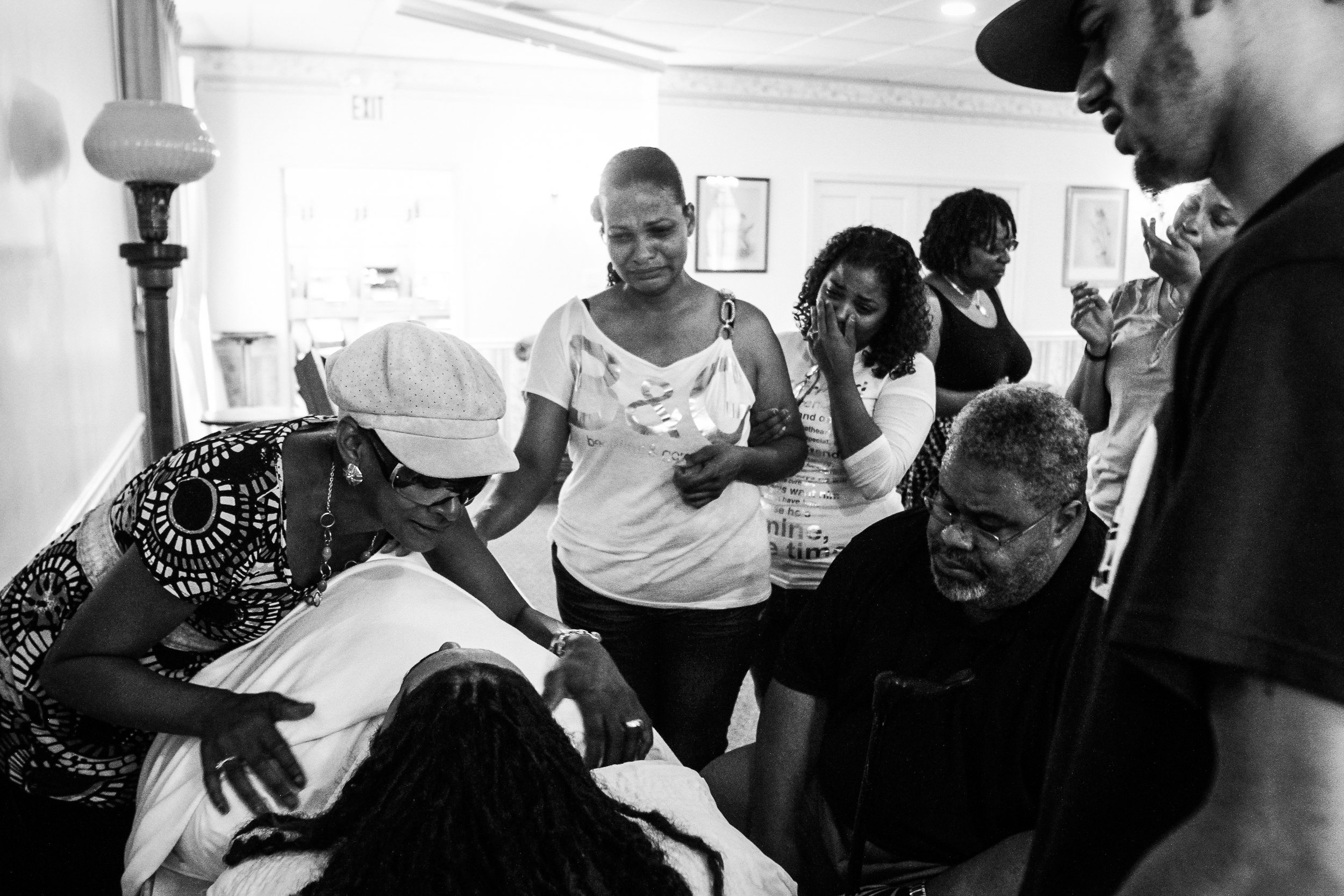
Andrew Renneisen's project 'Violent Times' got an Award of Excellence in Documentary category at CPOY 69. Catching Photo of Yours (CPOY) is a new CPOY Blog feature that gives photographers a chance to share the emotional and technical aspects of making their award-winning photograph.
My story, Violent Times, originally started from internship assignments at the newspapers I was working on at the time. I covered a few vigils in Wilmington and Atlantic City, and realized violence was affecting so many people in the cities throughout the United States. I decided that I wanted to show this on a deeper level so I started working on the story on my own as a personal project. I had help through the Alexia Foundation, which funds documentary projects that promote social change.
By being present in communities affected by violence, I was able to meet and connect with people who wanted their stories told. I think building trust is the most important part of gaining access for a story like this. By being honest and open about my intentions, I was able to build trust with the people I photographed.
I think the image of Zachary Taylor and his mother at the funeral home is one of the photographs which has affected me most. I was 20 years old at the time I made this picture. Mr. Taylor was 19 years old when he was killed in Atlantic City. His mother invited me to come with them to see her son’s body for the first time. On my way back to my car after making these photographs, I found myself weeping, which had never happened to me on an assignment before.
It was the first time on an assignment I realized how powerful the camera can be, and I think this moment had a profound impact on the way I thought about this story. I don’t necessarily think I am going to change the world through my stories, but if I can have the viewer see something from a different perspective, or think differently than before, I feel like I have done my job.
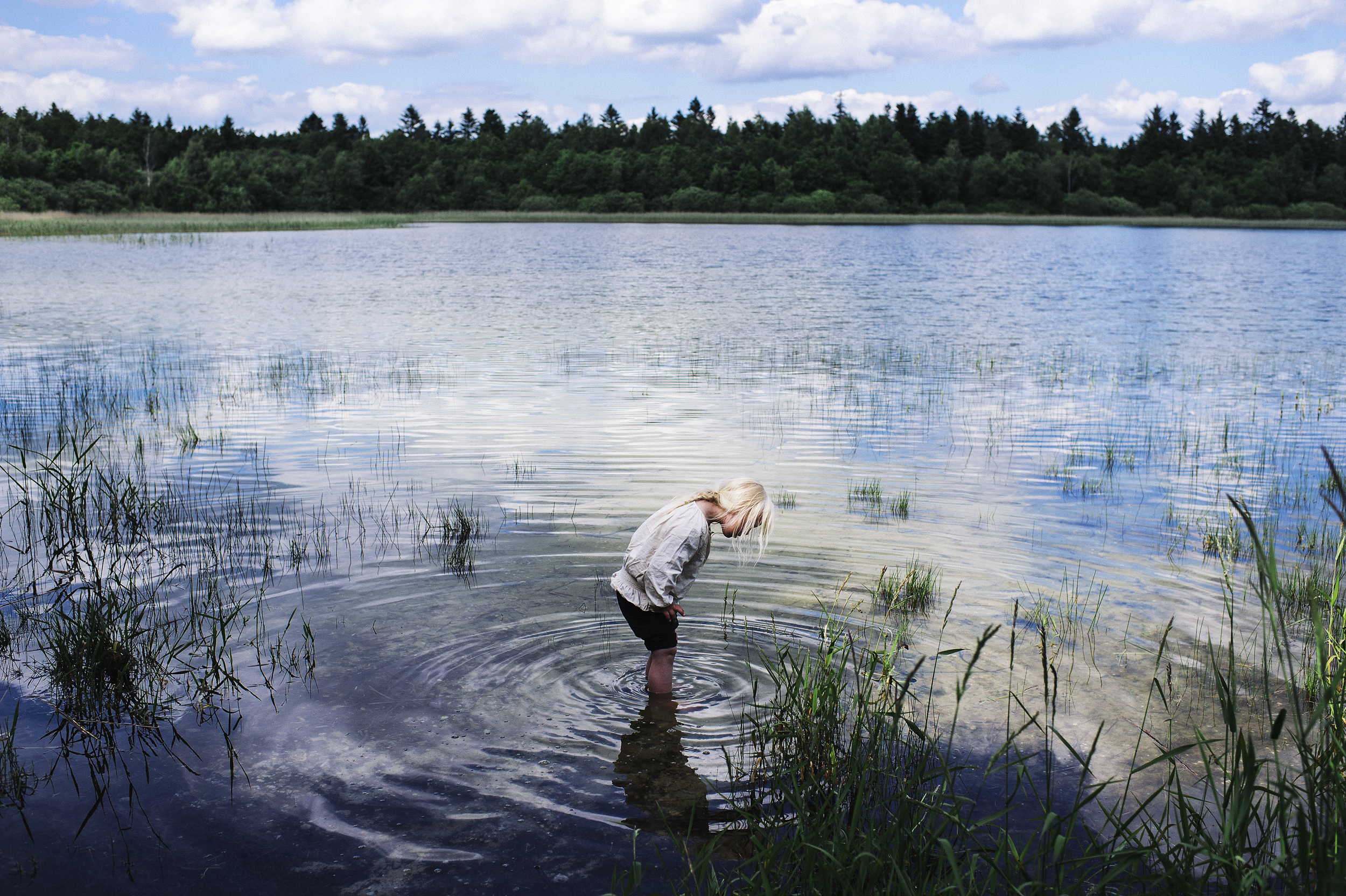
Mario Wezel's story got an Award of Excellence in the Documentary category and was a part of his CPOY 69 winning portfolio. Catching Photo of Yours (CPOY) is a new CPOY Blog feature that gives photographers a chance to share the emotional and technical aspects of making their award-winning photograph.
This set of images is from my story called “1in800”. I’ve been photographing Emmy, who has Down’s Syndrome, for the last two and half years by now.
This picture was taken last summer when I visited her and her family for a week in June. Her parents had to work that day so Emmy and her brother Kristian went on a afternoon trip with their grandmother. We drove through the lush green Danish countryside and arrived at a playground in the middle of the forrest. For about an hour we were playing hide and seek and used the slides and swings. After a short lunch break we walked back to the car and the grandmother allowed Emmy and Kristian to go play at the water. We all took our shoes off and dipped our toes in the fresh water. Emmy was braver then her younger brother and walked out into the water. I was following close behind taking pictures and looking out in case she would walk too far. Emmy suddenly stopped and it was totally quiet around her. It almost seemed like nothing was moving besides the ripples of water around her. She started starring down on her feet and stood like this for a few seconds. I could’t really tell whether she was looking at her own reflection or at her feet on the ground of the lake, but she was so focused that nothing around her could irritate her.
In the end I chose this picture to be part of the story because of that moment. Also the time leading up to it reminded me so much of what it feels like to be a child. When the world around you is still so big and exciting and you just explore everything around you. In this particular moment nothing reminded me of the fact that Emmy is a child with special needs. She was just a child, exploring the world, being curious about what happened around her.
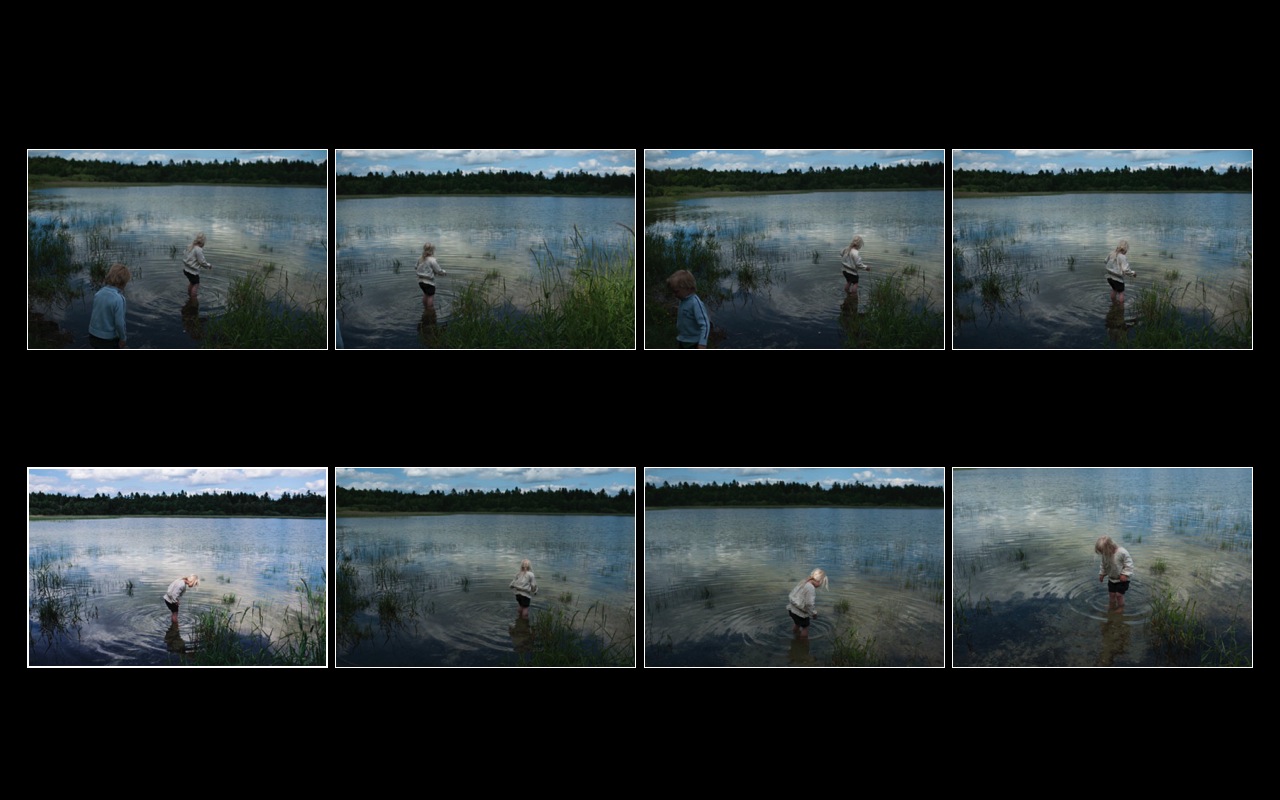
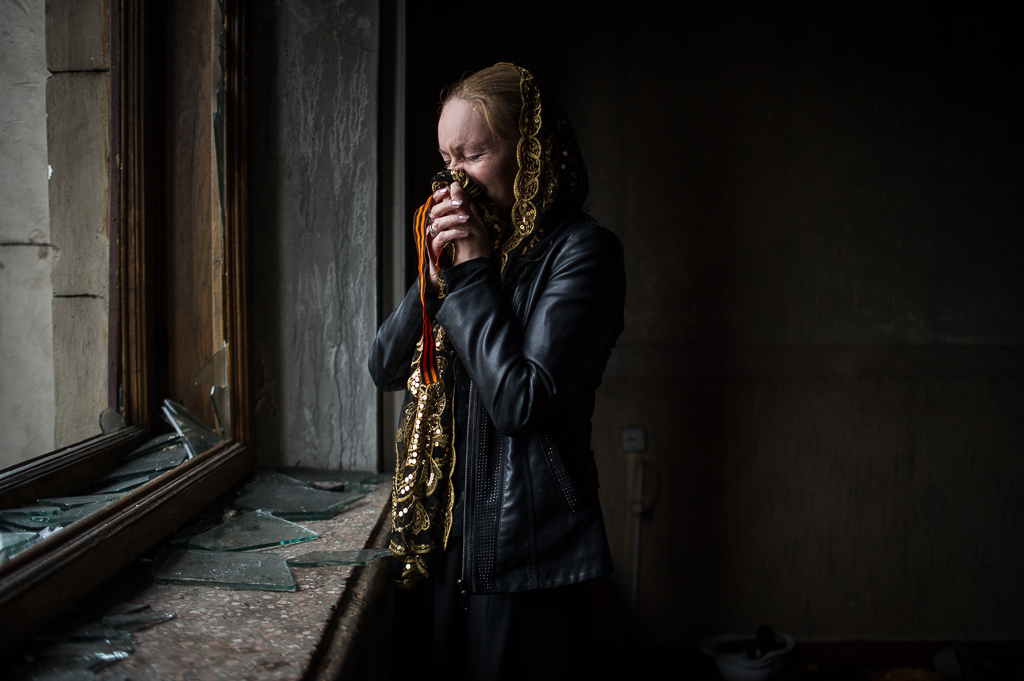
Alexey Furman's photograph 'Deadly clashes in Odessa' got Gold in General News at CPOY 69. Catching Photo of Yours (CPOY) is a new CPOY Blog feature that gives photographers a chance to share the emotional and technical aspects of making their award-winning photograph.
On the early afternoon of May 2, 2014 I was home in Kiev when I first heard about the violent clashes between pro-Russian and pro-Ukrainian protesters some 300 miles away in Odessa. I was contemplating if I should go there when news about the Trade Union House broke. Debate surrounds what exactly happened at the makeshift headquarters of the pro-Russian protesters, but at some point it caught fire, which resulted in over 30 deaths. Among the victims were those who burned alive and others who had jumped out of windows in desperation. I quickly scrambled onto the last bus to Odessa around midnight, and by morning I had arrived near the Trade Union House.
A horrifying scene waited. Everything had obviously ended by then with the exception of some communal workers cleaning the square nearby. The riot police would not let anyone inside the building while the investigation was underway. So I photographed outside and came back around noon when people started bringing flowers and candles to the stairs of the building. Some had lost loved ones in the terrible standoff. And although it was an incredibly sad scene, the crowd managed to simultaneously conduct a vigil and peaceful protest. However, there were some minor clashes with riot police.
The next day events continued in much the same way, but with a bigger crowd of around three hundred pro-Russian protesters. At some point the police literally vanished from the scene, and the crowd took notice. Slowly, people took refuge inside the burnt Trade Union House. I followed them in and sensed they were still grieving, but now also extremely angry.
I headed to the second floor and took some pictures of the crowd outside through a window. After which time I looked to my right and saw a woman holding a St. George ribbon crying her heart out. I crouched against the wall, framing the bright sky out of the picture and centering the woman. I did not want to interfere with her grief long and left as soon as the voice inside told me it was enough.
The resulting picture represents to me not only this tragedy in Odessa, but also the myriad other tragedies that have taken place across my country the last two years. It is a sad reminder of the constant grief people suffer for their deceased loved ones in yet another conflict that could have been avoided.
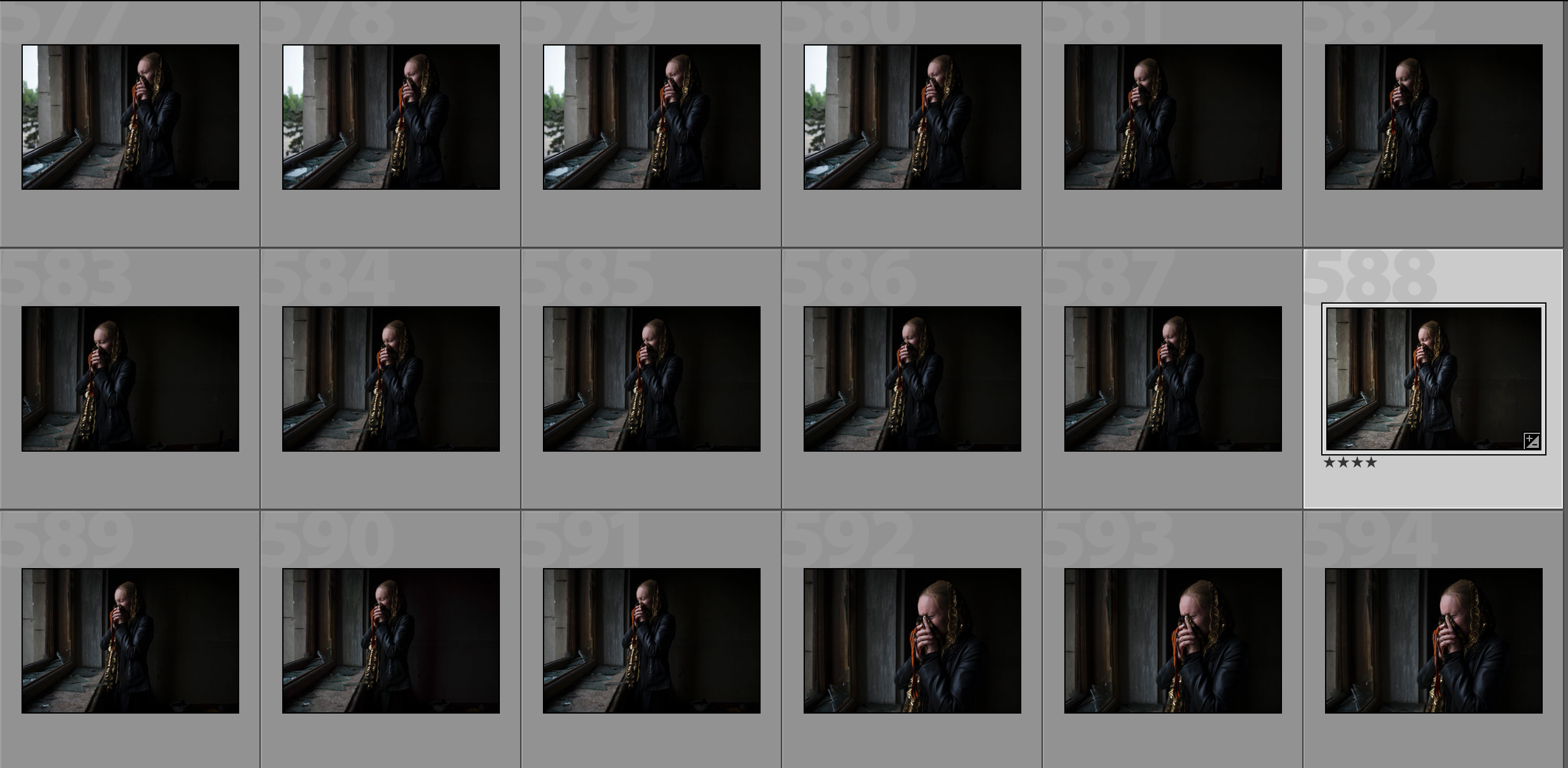
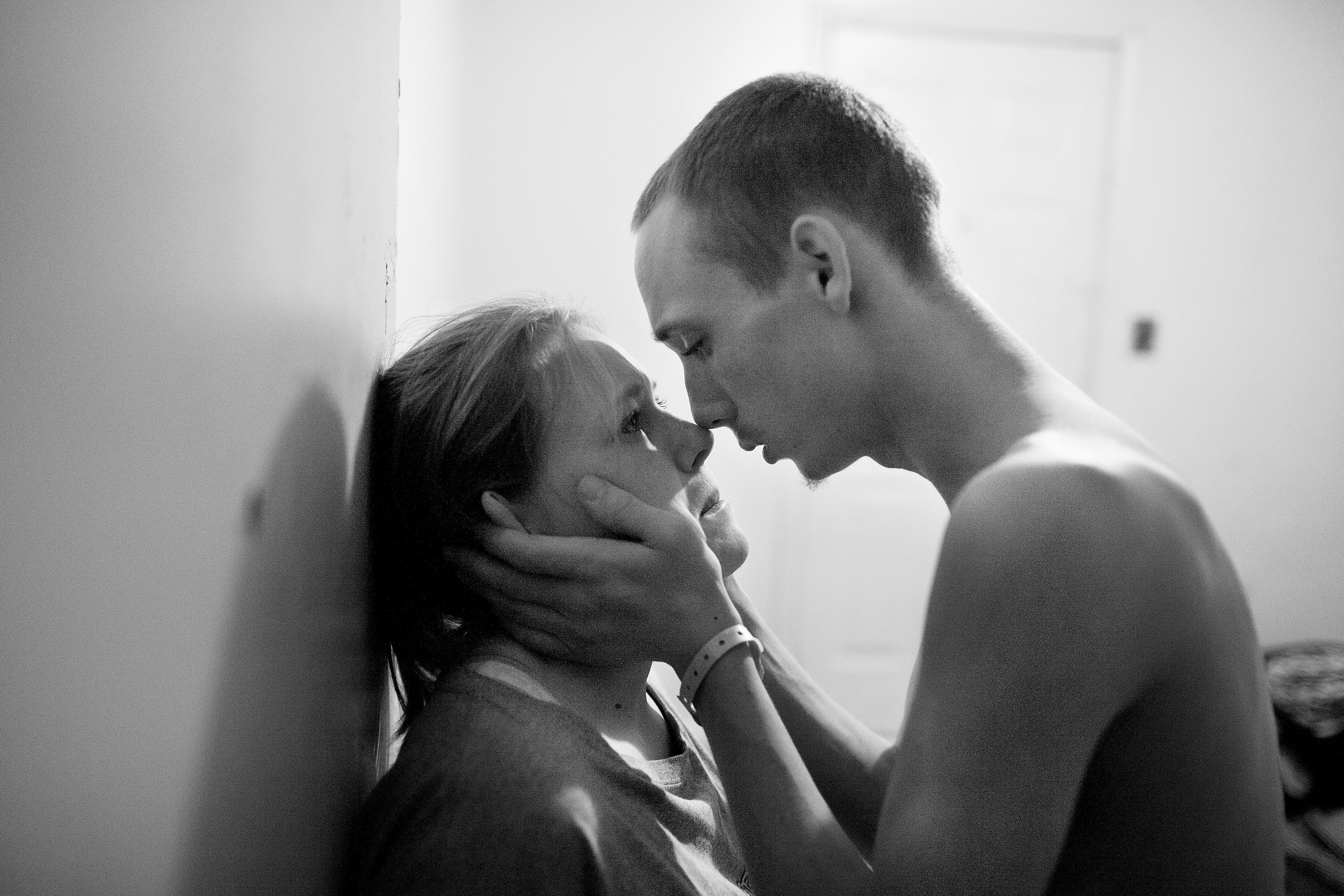
Austin Anthony's story 'Serenity' got Silver in Domestic Picture Story at CPOY 69. Catching Photo of Yours (CPOY) is a new CPOY Blog feature that gives photographers a chance to share the emotional and technical aspects of making their award-winning photograph.
I first met William and his family my freshman year of college. The first photo story I ever did was about his struggle to stay in high school. Throughout college I kept in touch, and his family became my friends. I would stop by a couple times a semester to catch up.
During one of those visits they happily told me there was a grandchild on the way. I decided to do a story about the pregnancy only knowing that they were open to me and that they didn’t hold back emotions when the camera was around. Everything had gone fairly smoothly for them up until the birth. William and Stephanie had gotten their own apartment, William had a minimum wage job, and friends and family members had given them several of the supplies they would need once the baby arrived.
The day the photo was taken began at court. The judge essentially said that the nurses were concerned about their behavior with the child and that they wanted to put Serenity (the baby) into temporary custody while they took parenting classes. Over the course of the day they began to speculate and blame each other, which lead to a long drawn out fight. I was there for all of it, which helped me feel a little more comfortable taking photos. I was one of a handful of people that knew the entire situation so I didn’t feel out of place. It was still very difficult to take the photo. It’s awful to be around two people fighting and I had to constantly remind myself that if they wanted me to leave they would have said so. And then after a lot of tears and yelling this moment happened. It felt like such a private moment, and it was so pure and beautiful. It was the moment they decided to try to let love win and not have this horrible situation tear them apart. He held her face and told her he wanted to stay together and make it work after hours of fighting. Prior to all of this I thought those moments only happened in movies.
It was one of the most emotionally exhausting days of my life. It began at 8 in the morning at the courthouse and I didn’t get home until 10 at night. I knew I had seen something special, felt lucky for that, and happy that they decided to try to make things work. But most of all I was heartbroken that they weren’t holding their baby.
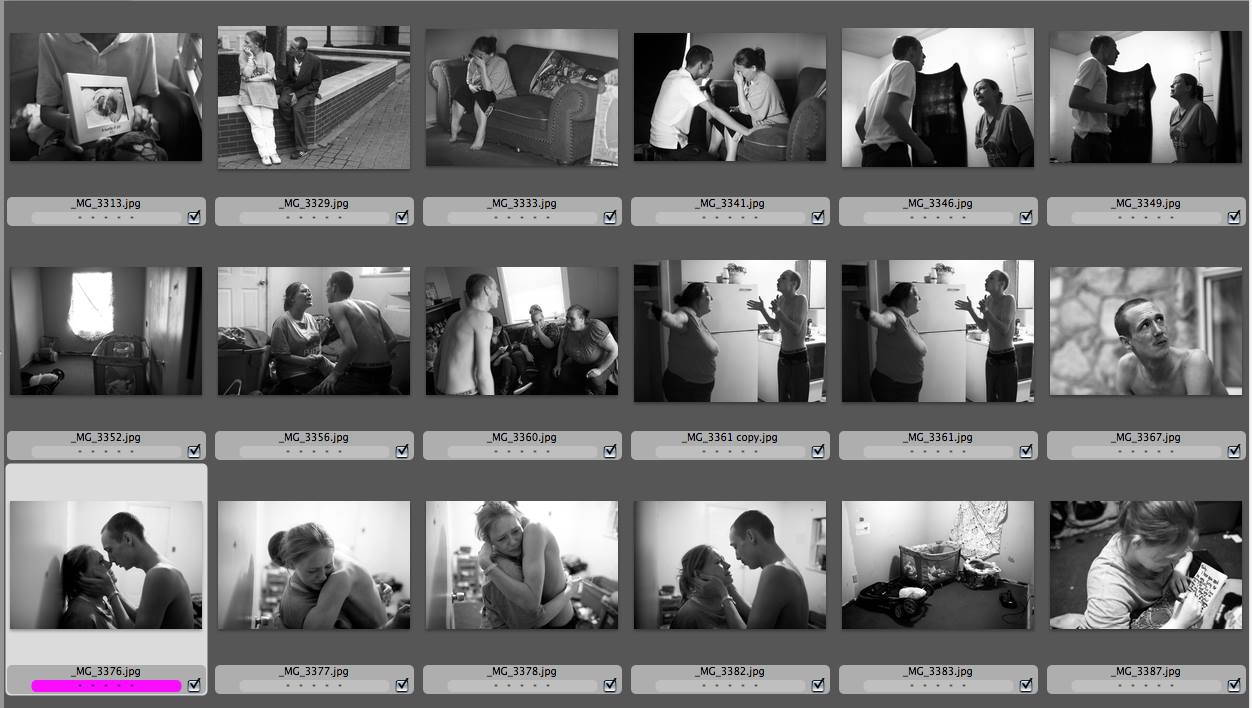

Judging of the 70th College Photographer of the Year contest begins on Sunday, November 8, on the University of Missouri campus with Spot News category. This year CPOY got 11324 entries from 122 schools in 24 different countries.
There are plenty of possibilities to follow the judging online, if you can’t make it to Columbia this year.
Follow our screencasts that will be posted as soon as the first couple categories are judged.
The latest information and web updates will be available on Twitter via @collegephotog or on Facebook: College Photographer of the Year. CPOY has also recently joined Instagram, so look us there at @collegephotog.
Click here to view this year’s judges and approximate schedule.
Stay tuned for interviews with the judges; a discussion between last year’s Portfolio winners; a peek behind the scenes at Tucker Forum; or read the stories behind winners’ images in our new feature, Catching Photo of Yours.

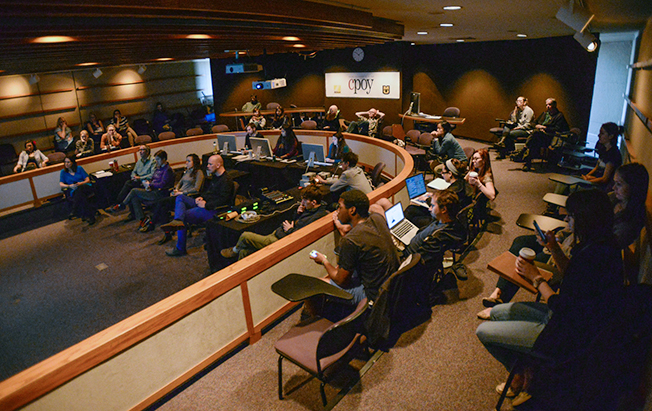
Photo by Loren Elliott/CPoY
Judges and attendees look on during the final round of judging for the College Photographer of the Year Sports Feature category on Nov. 10, 2014.
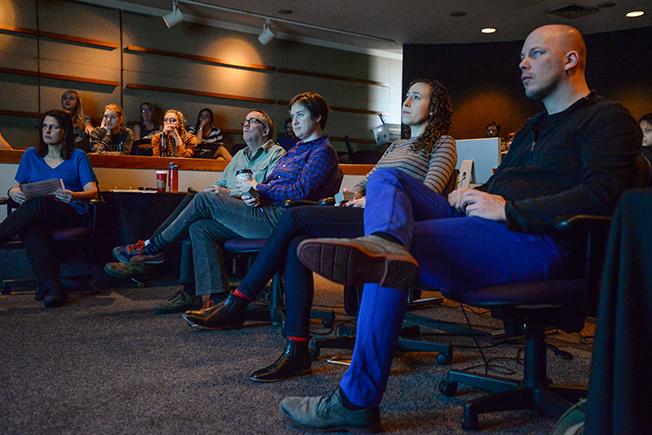
Photo by Loren Elliott/CPoY
From right to left, judges Uwe Martin, Jesse Wender, Preston Gannaway and John Sale view the Sports Feature category on CPoY's second day of judging Monday, Nov. 10, 2014.

CPoY: What impact did winning cPOY have on your work or professional career?
Eich: Winning cPOY was incredibly formative because it opened the door to National Geographic, a client that I still enjoy hearing from occasionally. cPOY introduced me to a lot of wonderful people, not only at Nat Geo but throughout the industry. It helped to put my work out there in a way I'd never been able to before and aided in the start of my freelance career, which proved to be incredibly helpful because less than a year later I was welcoming my first daughter into the world.
CPoY: What is the latest photo project you've been working on?
Eich: There isn't one particular project I've been working on ... since CPoY I worked more on "Carry Me Ohio" before moving to Virginia in 2009. In 2010 I started a project called "Sin & Salvation in Baptist Town" about a town in Mississippi which is ongoing as well as another chapter called "The Seven Cities" about my home in Virginia. I continuously photograph family and my daily life.
Here are a few 6x7 images from this year made while working on the Baptist Town project as well as "The Invisible Yoke" and my graduate studies at Hartford Art School's Photo MFA program.
CPoY: Why did you choose and continue to pursue photography?
Eich: Photography found me at a very early age, and it has always felt like the medium with which I can best communicate. This isn't to say that it's an easy path ... there are plenty of days where I wish I had a real job, and then other days where I realize that this is the best job in the world when it isn't taking me away from my family.
CPoY: How does one develop a personal photographic style?
Eich: Everyone is different, but style comes as a result of having something to say and knowing how it needs to be said.
CPoY: How has the medium of photography changed for you since entering cPOY?
Eich: Haha. Photography has been in a state of rapid change for some time now, but it has certainly been picking up the pace since 2006. For instance, I never really thought too much about Instagram or shooting assignments with my iPhone or having people "follow" my work through an outlet like that. I wasn't very worried about motion in 2006, though at this point I consider it an important addition to my skill set. That said, I still try to focus on image-making and let other more talented folks work on the editing end of things.
CPoY: What advice do you have for student-photographers on entering photo contests?
Eich: It's like fishing ... you won't catch anything if you're not out there, (i.e. can't win if you don't enter) and it's a numbers game. The more you put your work out there, are rejected, refine it, think about it, reformulate it, resubmit it, the more rapidly you are forced to confront your weaknesses and the more likely you are to succeed.
CPoY: What advice do you have for student photographers/young professionals who are ready to graduate or start in the field?
Eich: Don't turn your nose up at work ... always produce to the best of your ability and listen to your client's needs. There is no guarantee they will ever call you again. You are not just in the business of image-making, but in relationship-building. This carries through the people you photograph and the people you work for. Put your work out there, get torn apart, get better. There is no place for ego in this industry, be honest, genuine and open to feedback and be resourceful.
Interview conducted by T.J. Thomson and Alex Scott.
CPOY Director Rita Reed calls College Photographer of the Year Sara Naomi Lewkowicz to inform her of the panel decision. Sarah was in London at the time of the call and was quite sleepy at 2:30 am..

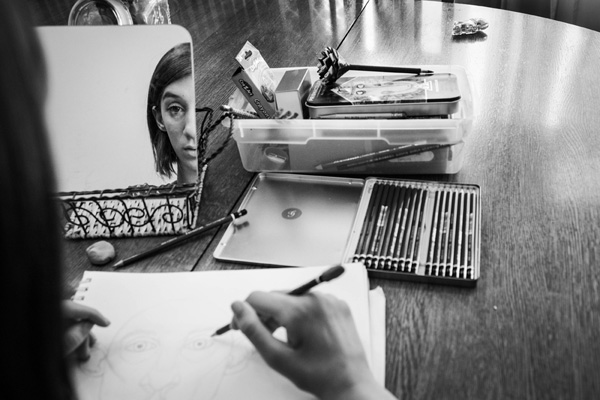
Q. How did you find out about getting a gold medal? What was your first reaction?
A. I was at home and a group text was sent out among my Syracuse photo friends. I didn't have my phone on me at the time and so my roommate saw it first and broke the news to me, which was then followed by a lot of "What! No! Are you serious!?" responses. I then called Gena's mom, Sue, to put Gena on speaker phone to share the news.
Q. Can you tell us something about making the winning story?
A. I started photographing Gena Buza in October 2012 when I needed a "successful student" to photograph for the Syracuse Fall Workshop. An instant connection was made and I have continued documenting her story through still and moving images ever since. The winning set of images were made the first two weeks I met her and her family. I made the decision to submit a smaller time frame because of the fluidity in the edit of those eight images.
Q. What got you first into photography?
A. Being the youngest sibling of four children there was always a lot happening in my family. My mom would hand me a camera at every basketball game, graduation, holiday function and I would always be eager to photograph everything happening around me. My earliest memory of photography was in the first grade at a high school basketball game with my purple 110 camera.
Q. Do you have a photographer you admire/ inspires you? Can you tell us something about that?
A. Lynn Johnson is one the most inspiring photographers to me. Lynn's images are ones that stick in my head and leave a feeling in the pit of my stomach to do more. She inspires and reminds me that images can change lives and bring awareness to stories right in our own backyards or in the farthest corner of a country we may never see with our own eyes. I was lucky enough to be apart of a group of Syracuse master's students who worked with her this past summer and saw first hand the impact she makes when working with the people around her.
Q. Do you have any tips for other college photographers?
A. Find a good balance between listening to yourself and exploring the unfamiliar. Throw yourself in the stories that you connect with and are passionate about and then take on project that makes your expand your comfort zone. And remember that "if you're dreams don't scare you, you aren't dreaming big enough."
To see more of Taylor's work, click here
Interview by Hany Hawasly
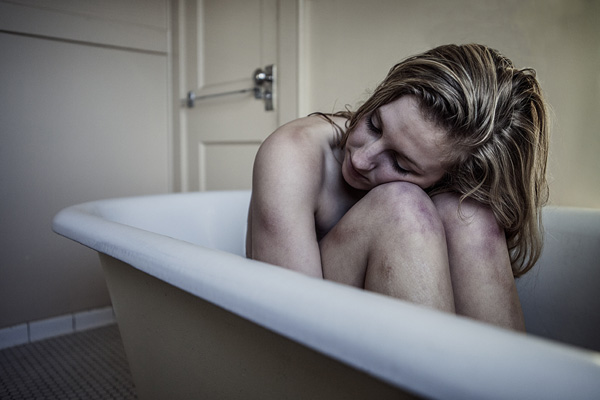
Q. How did you find out about getting a gold medal? What was your first reaction?
A. I was glued to my computer screen, continuously refreshing the CPOY website and twitter page to see when the Illustration winners would be posted. I was shocked when my photo popped up on the screen! I was so excited.
Q. Can you tell us something about making the winning photo?
A. I originally shot the winning photo for a different purpose. But then once I was going through selects I found this one frame where she looked sad and lonely. I decided to play around with the image in photoshop and take the story further. The winning image is what I came up with.
Q. What got you first into photography?
A. I honestly don't know what first got me into photography; I think it may have been fashion magazines. I always found myself buying magazines just to look at the advertisements in the front and editorials in the back. I tend to do mostly fashion photography now, so that makes sense.
Q. Do you have a photographer you admire/ inspires you? Can you tell us something about that?
A. Tim Walker is one of my main inspirations. I love the fantasy element in his work. More and more I see myself trying to create the same moods and settings he does.
Q. Do you have any tips for other college photographers?
A. My advice would be to continuously create and explore new styles. You never know what you're capable of until you try.
To see more of Sarah's work, click here.
Interview by Hany Hawasly
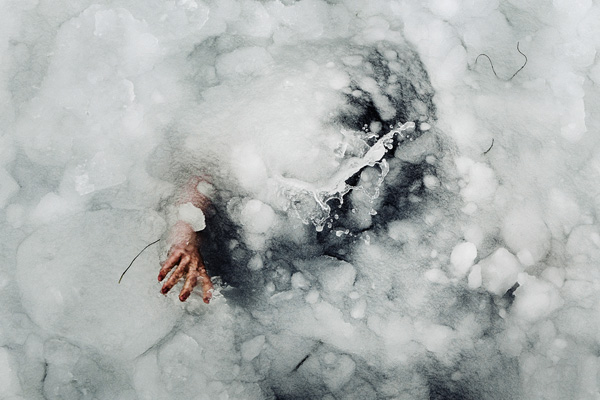
Q. How did you find out about getting a gold medal? What was your first reaction?
A. I was working late at the newspaper that day and just finished editing some pictures. While I waited for Photo Mechanic to transfer the images I went to the kitchen to make a cup of coffee. The water was boiling and I got my cellphone to check Facebook for some updates. There it hit me; "Add another gold to the list for interpretive eye, folks!", someone wrote in the group for danish photojournalist students. I couldn't believe it – my name was tagged to me message. I forgot all about the coffee and ran down to my computer, cancelled Photo Mechanic and got to CPOY website. They were right. And I was very happy.
Q. Can you tell us something about making the winning photo?
A. The picture is a part of a series made with young winter swimmers from ISS Icebear on Amager Strand, Copenhagen. The series was made for a weekly photo spread in the danish newspaper Politiken back in March when the winter was really bad and there was snow everywhere. Somebody told me about this group of children who had been swimming all winter. I thought it might be a funny and different way to illustrate the weather situation.
The winning photo is the first image of the series. It is the only reportage photo where the others are portraits made on a white background. I think that the photo sets the scene without showing too much. It tells us something about where we are and what is going on but still it asks some questions.
Q. What got you first into photography?
A. I first got into photography in my first year of high school when I bought a DSLR camera. In the beginning I did not have any idea about becoming a photographer or working with photography as a serious matter. I just wanted to photograph the things around me; my family, my friends and my neighborhood.
Today I still love photographing the ordinary and close things.
Q. Do you have a photographer you admire/ inspires you? Can you tell us something about that?
A. As much as I like taking photos, I love looking at others work. I get my inspiration from many aspect of photography and art – not only from photojournalism. To me photography is best when you mix different genres to tell your story.
I think that these photographers does that very good:
James Mollison, Christopher Morris, Roger Ballen and of course, the Master of Color, Martin Parr – just to mention a few.
Q. Do you have any tips for other college photographers?
A. Shoot every day. But also think about what you are shooting and how you are doing it. To me photography is storytelling so it all comes down to how you want to tell your story. As a photographer it is your unique view on the world that matters.
To see more of Daniel's work, click here.
Interview by Hany Hawasly
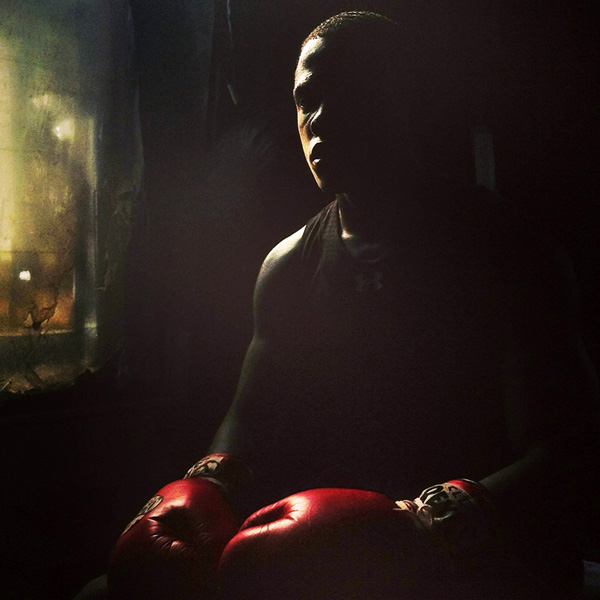
Story: North Philly
Q. How did you find out about getting a gold medal? What was your first reaction?
A. I got a text from friend and fellow MU grad student Kholood Eid after I placed in both Feature and Interpretative Project. I was really shocked. I'm still in shock, but super honored and excited. This is motivation to keep working harder than ever and to continue to make important, intimate pictures.
Q. Can you tell us something about making the winning project?
A. Well, for the feature category, that was a moment I ended up seeing and just waited for the right composition -- Gage framed through the door. I shot a series of frames, but chose the one with his leg in the air because I thought it worked the best visually. I ended up not having to move much because as soon as I saw Gage playing with the gun I was already at the point where I could layer my frame like I ended up doing.
For interpretative project those were a series of images I made using an iPhone camera while back home in Philadelphia over winter/summer break. It's really refreshing to make pictures like that. I'd go out and shoot plenty of times without a DSLR. I didn't start shooting with a mobile phone until January, but I'm really enjoying the freedom that comes along with it.
Q. How did you first get into photography?
A. I was first interested in working in the film industry. I wanted to be a screenwriter and then a cinematographer. I finally just took a photo class for fun while I was an undergraduate at Temple University in 2009. I fell in love with the ability to make pictures that people can react to and understand their world by viewing them.
Q. Who are some photographers who especially inspire you, and why do you admire them?
A. As a native Philadelphian, I am a huge fan of former Philadelphia Inquirer photographer Eric Mencher's work. He has a wonderful eye for light, color and scenes. I enjoy looking at his work and being constantly inspired to make thoughtful, interesting images.
Q. Any tips for other college photographers?
A. Keep pushing yourself. Never stop. Breathe photography, live photography and take your time creating a body of work that shows your personal vision. Your subjects should be more than just "subjects." Give them a voice and shine a light on people whose stories might otherwise be unheard.
To see more of Kevin’s work, click here.
Interview by Leah Beane and Hany Hawasly
Yulia Shandurenko is an assignment desk analyst at ITAR-TASS Photo Agency. ITAR-TASS is Russia’s central information agency established in 1904. Yulia is a part of a journalist exchange program sponsored by the International Center for Journalists in Washington, DC.
Q. What is your most recent project?
A. I organized a photo report about 50 religious fanatics at the Perm territory in their log house in the abandoned village of Cherepanovo, near the village of Nyrob, some 1230 km (765 miles) northeast of Moscow.
Q. Do you have any competitions similar to CPOY in Russia?
A. We don't have a special competition for photojournalism students; they can take part in one of the renowned competitions like Best of Russia and Silver Camera.
Q. How do professional photo organizations in Russia find new photographers?
A. We constantly receive portfolios from photojournalists from all regions of Russia and we evaluate them to decide whether to work with these photojournalists or not.
Q. After attending news categories judging, do you agree with the judges’ decisions?
A. I saw many bright, qualitative, interesting images of various aspects of human life get eliminated and lots of pictures of violence, human suffering, injury and funerals chosen as winners. I find this to be one dimensional and I’m afraid of this tendency in modern photojournalism because it does not create or find something beyond what you can see. It’s rather more like exploitation of human suffering and a display of disrespect to victims of tragedies. I know that many of my colleagues may disagree with me, but I believe that the real mastery of photography is achieved without abusing the subjects in your reporting.
Q. Are these discussions any different than the ones you would have in your agency in Russia?
A. No, I don't feel like we have different visual standards. ITAR-TASS Photo Agency is working for international subscribers, our images conform to worldwide standards.
Interview by Hany Hawasly
Judging for CPOY 67 Still Division categories starts at 9 a.m. today with the Sports Action category and continues through categories on Wednesday, Nov. 14th. CPOY judging is open and entrants are invited to attend. Judging takes place in Tucker Forum of Gannett Hall at the Missouri School of Journalism on the University of Missouri-Columbia campus.
If you are unable to be with us in person, please keep an eye on the judging via the podcasts on the cpoy.org website. We will be updating this blog with behind-the-scenes content from the contest judging period. Check back soon for more updates and make sure to follow @CollegePhotog on Twitter for updates during the judging week.
Are you looking for the previous year's blog content? Click here.

CPOY Director Rita Reed discusses the history and educational focus of the College Photographer of the Year competition. Interviews with Liz Baylen, Patty Reksten, Eric Seals and Joe Weiss are posted below. Melissa Wiley will be joining CPOY on Thursday for the judging of the multimedia categories. Biographies for all the judges may be found here.
Judging for CPOY 65 starts at 9 a.m. Monday, Nov. 8th with the Sports Action category and continues through the Multimedia categories on Saturday, Nov. 13th. CPOY judging is open and entrants are invited to attend. Judging takes place in Tucker Forum of Gannett Hall at the Missouri School of Journalism on the University of Missouri-Columbia campus.
If you are unable to be with us in person, please keep an eye on the judging via the podcasts on the cpoy.org website. We will be updating this blog with behind-the-scenes content from the contest judging period. Check back soon for more updates and make sure to follow @CollegePhotog on Twitter for updates during the judging week.
Are you looking for the previous year's blog content? Click here.
With summer internships and graduation looming six months away, assembling a portfolio is the essential piece in applying for internships and jobs. But it's hard. Photographers constantly wrack their brains looking through bodies of work. Which images should they use? In what order? What does this image convey? What does the portfolio, as a cohesive unit, say about the photographer as an artist and a photojournalist?
After sitting through several hours of judging in the portfolio category, I've compiled a list of the different pieces of advice I gathered:
• The first photo sets the tone of the portfolio and photographer.
• Show a variety: composition, light, types of photography, moments, etc.
• Try to offer unique ways of seeing.
• Convey your personal vision as an artist and photojournalist – one that serves as a cohesive unit.
• Focus on moments. Offer intimate views into your subjects, so we connect with people on a deeper level.
• Use layering to show multiple moments within a single frame.
• Surprise the viewer. Show us something we've never seen before.
• Challenge yourself. Stick with long-term stories that fuel your passion. Connect with subjects and offer visual variety. Trust your instincts.
• Take a risk. It will push you beyond what you would normally think of doing. You never know what crazy idea could make an excellent photograph.
• Bring more than your eyeballs. Don't just be a visual photographer; remember to tell a story.
• Have something to say. Offer your point-of-view on life and the world.
• Follow your own path; follow your heart. Photograph what feels right for you, don't feel like you have to trail the paths of others all the time.
• Edit tightly. One photo can ruin a portfolio. I'm not kidding. I saw what could've been an award-winner get voted "out" because of one image.
• And remember, treat your subjects with respect. Empathize with your subject, make the viewer feel. Don't, and I repeat, DO NOT photograph in a way that is at the expense of your subject. We are all human beings. Treat people with the respect and dignity they deserve. The way a photo is communicated may read differently with a viewer than what you intended. Be aware of the sensitivity of the subject-matter and your viewer.
I know this is a lot to think about, but hopefully this list will help when putting together your portfolio and making better photographs.
If you want to understand this advice on a more concrete level, watch the podcast. My points will be reiterated with specific images.
What makes a sports action photo? There's no formula--check the judging podcasts for a more thorough discussion of the category--but that doesn't mean there aren't certain trends happening in the field.
To get a better idea of these patterns, CPOY took the in-camera data for all 636 of the images entered in sports action and crunched it according to aperture, shutter speed and focal length (we added camera make and model just for fun). The charts below show the most common settings (and cameras) used by entrants. Not all of the images processed had numbers for each category, making exact percentages hard to determine, but of the available data, the relative proportions are accurate.
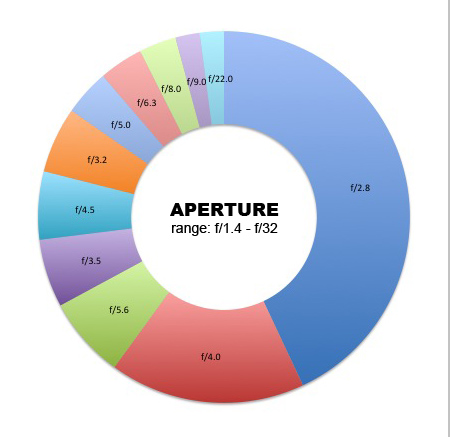
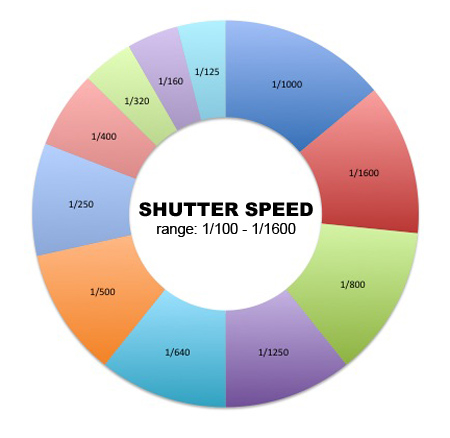
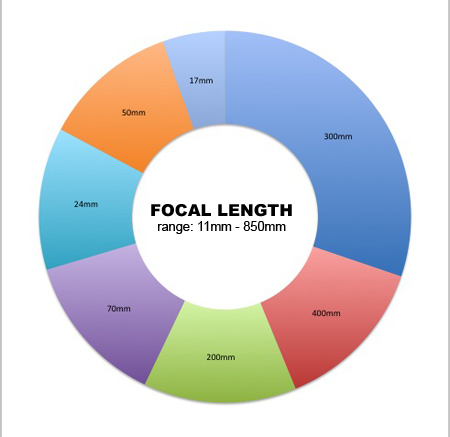
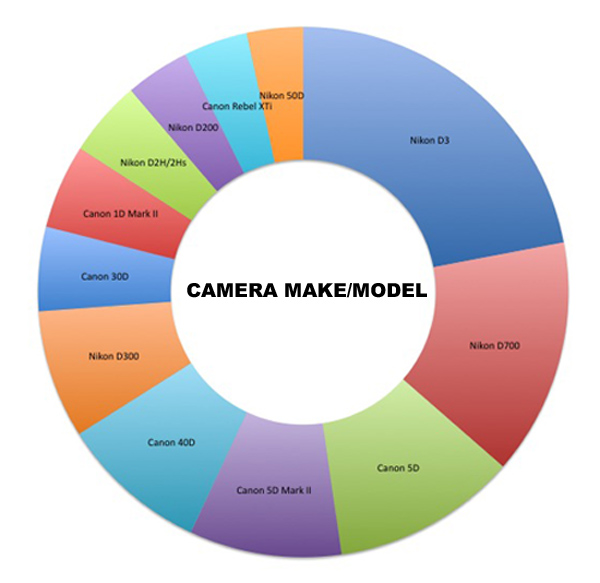
So if you're out shooting sports with your D3 and 300mm, working the f/2.8, 1/1000 combination-- you're not alone. Just remember: in the end, it's the photo, not the camera or settings that matter.
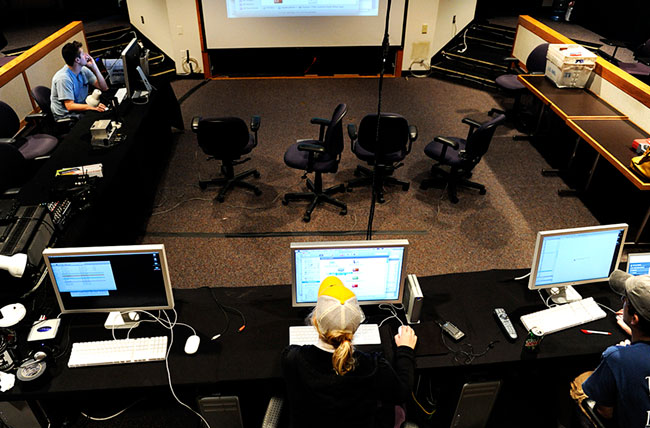
Judging in the 64th College Photographer of the Year competition begins tomorrow morning on the University of Missouri campus with the sports action category. If you can't make it to Columbia this year you will still be able to keep track of the judging progress and additional behind-the-scenes features on this blog.
Up to date information regarding the judging schedule and web updates will be available on Twitter via @CollegePhotog. Additionally, this blog is available on FeedBurner or you can sign up for email updates with the form in the left sidebar.
Click here to view this year's judges and approximate schedule.
Make sure that you tune into the CPOY screencasts or subscribe to our iTunes podcast channel to watch the semi-final and final rounds of judging.
Check back for more. The judges arrive Saturday evening and we will be posting video introductions sometime on Sunday.

Tear down of the CPOY setup in Tucker Forum. It is amazing how much stuff (and especially how many cables) are needed, just to see a few pictures.